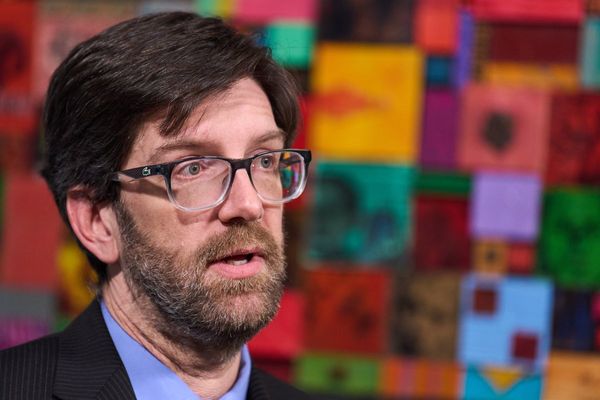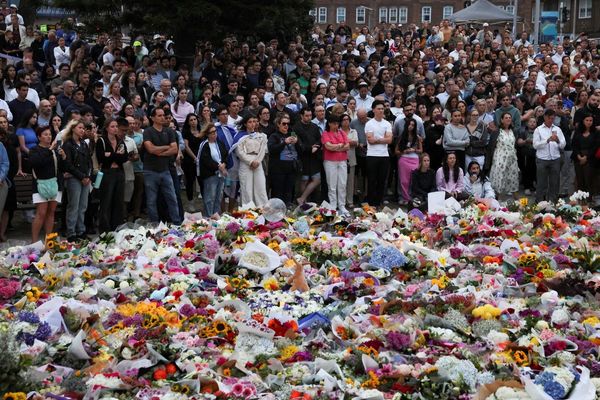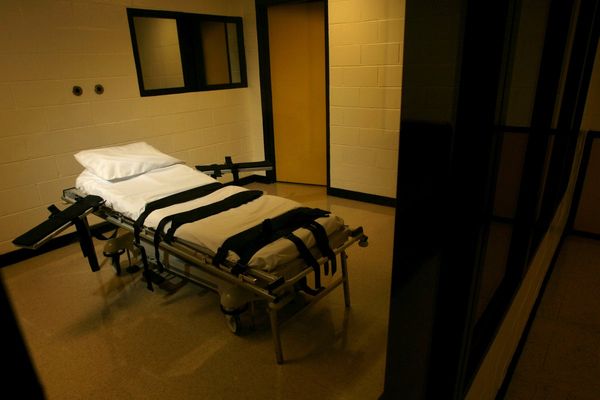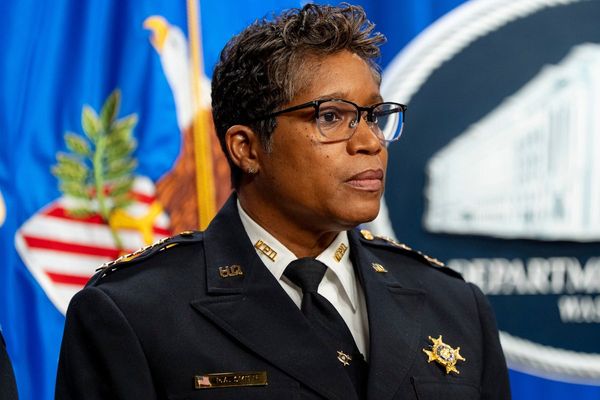
‘For me, red is always a representation of blood and losing people, so I tend to use this red fabric to represent our trauma.” The Sudanese photographer Hashim Nasr is talking about how the war in his homeland has influenced his work.
Before the start of the conflict in 2023, the figures in his photographs were often covered in flowers or holding heart shapes, challenging stereotypes of masculinity. Now, flowing red fabric representing trauma, loss and bloodshed is a frequent motif.
Nasr describes his art as “dreamlike” – his project On War and Displacement features a series of striking, surreal images with anonymous figures wearing traditional white Sudanese robes, their identities concealed beneath conical masks.
In one of his most recent works, two figures sit in front of a TV, from which a length of red fabric flows out towards them.
“Me and my family are always stuck in front of TV, watching news of what’s happening in Sudan,” says Nasr, who now lives in Egypt. But, he adds: “All you get from TV is news of destruction, blood and loss.”
In other photos, the red fabric trails from a suitcase or flows between different buildings, representing how war has pushed Sudanese to leave their homes and find new ones.
War has also transformed how the dentist turned photographer views his work: from a form of personal creative expression to a tool for raising awareness about the situation in his country, which the UN calls the world’s largest humanitarian crisis.
“I feel this heavy weight on me to speak up. I need to express who I am and the impact this war has on me as a person [and] my family,” he says.
Nasr was on holiday in Egypt in April 2023 when the war in Sudan broke out and has not been able to return. He still struggles to adapt to life abroad, he says, living in a small home knowing that his large family house in Sudan’s capital, Khartoum, has been looted by militia fighters.
At least 3.3 million Sudanese have fled Sudan since 2023, with 1.5 million arriving in Egypt, according to the UN, while the remainder are spread throughout Sudan’s other neighbours.
While Nasr’s close family escaped Sudan, many of his relatives are among the 8 million internally displaced people. Within two months of the war starting, an uncle who had been on dialysis died because he was trapped in his home, unable to access treatment.
“It was really hard news for us to take at that time because we’d been asking them to go to a safer place, or at least get his medication,” says Nasr. “But anytime they tried to leave there were clashes outside.”
Nasr began experimenting with art during the Covid-19 pandemic, when his dental practice was closed, taking self-portraits and using friends as models. While he still does some part-time dentistry, art is now his main focus.
His work is mostly shared on social media sites such as Instagram but his images are earning attention in the art world, winning him the East African Photography award last year, a series of fellowships and a place in the British Journal of Photography’s “ones to watch” issue last year.
The striking masks in his photos were developed while trying to find a creative way to conceal the identities of his models, mindful of the risk to them and their families in Sudan if they were identified.
Some of his photos are a commentary on the war itself – such as a series called the Curse of Gold, which depicts men looming over a woman wrapped in gold fabric to represent the looting of Sudan’s gold resources by the paramilitary Rapid Support Forces.
But most of his work is about connecting with other Sudanese with shared experiences of trauma, loss and exile.
“I noticed this war isn’t talked about enough in social media or in the news,” he says. “I feel like it’s neglected and that gave me the motivation to talk more about it.”







